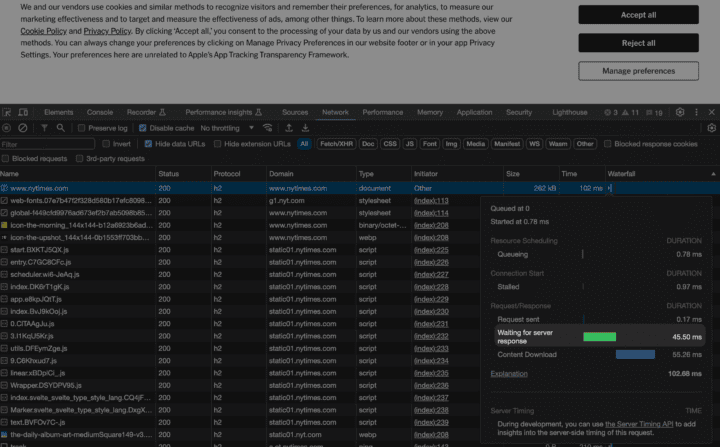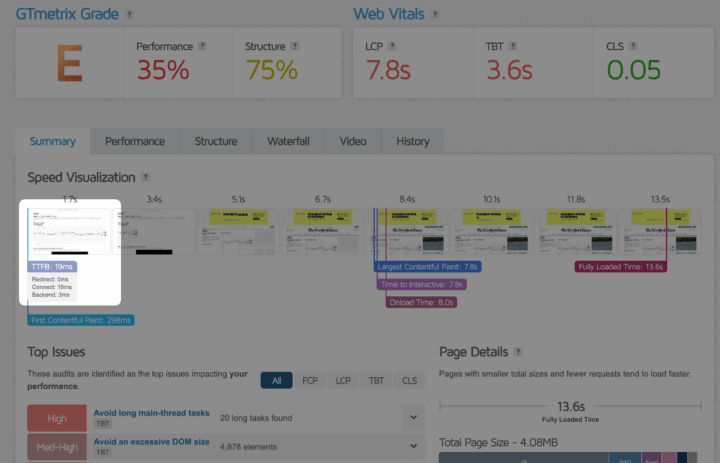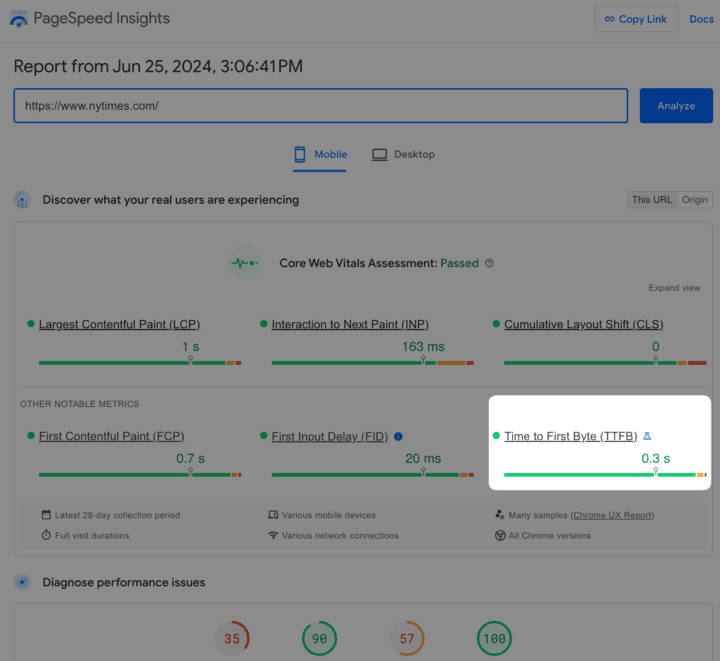Time to First Byte (TTFB) tells you how quickly a server responds with the first byte of data. Improving TTFB enhances user experience and boosts SEO. This article covers TTFB basics and offers tips to speed up server response times.
Key Takeaways
- Time to First Byte (TTFB) measures the efficiency of various processes such as DNS lookup, TCP connection, SSL handshake, and server processing; a good TTFB is 0.8 seconds or less, crucial for user experience and SEO rankings.
- Effective tools like Chrome DevTools, WebPageTest, and GTmetrix are essential for measuring and optimizing TTFB through real-time and geographic data analysis.
- Common causes of slow TTFB include server configuration issues, high database query load, and long redirect chains; optimizing server performance, implementing caching strategies, using a CDN, and upgrading to the latest PHP version are vital for improving TTFB.
Understanding Time to First Byte (TTFB)
The Time to First Byte (TTFB) is considered a critical metric. It measures the time between an HTTP request TTFB and the arrival of the first byte of the response. It encapsulates the time spent on:
- DNS lookup
- TCP connection
- SSL handshake
- server processing
Assessing the responsiveness of a web server and its ability to handle http request efficiently requires accurate measurement of TTFB. A smooth user experience, influenced by metrics like bounce rates and session durations, necessitates a good TTFB score.
Components of TTFB
TTFB consists of several key components that collectively determine the server response time. These include:
- DNS lookup
- TCP connection
- TLS negotiation
- Actual server processing time
Each of these steps contributes to the total duration it takes for the first byte of a response to reach the user’s browser. The server’s efficiency in handling these processes can significantly impact the overall TTFB measurement.
In the process of measuring TTFB, one should not overlook the full scope, which includes redirect times and server response generation time. Optimizing each component can lead to a lower TTFB, resulting in faster page load times and improved user satisfaction.
Importance of TTFB
There are several compelling reasons to strive for a fast TTFB. Firstly, it ensures that your website loads quickly, keeping visitors engaged and reducing bounce rates. Users are more likely to stay on a site that responds quickly, leading to longer session durations and higher conversion rates. In addition, TTFB significantly contributes to other performance metrics such as the Largest Contentful Paint (LCP), which have a direct impact on user experience and SEO rankings.
Search engines favor websites with lower TTFB, as faster sites provide a better user experience. Therefore, continuously improving TTFB can lead to better search rankings and increased organic traffic. A good TTFB is generally considered to be 0.8 seconds or less, making it a benchmark for optimizing web performance.
Measuring TTFB Effectively
A variety of tools are available to accurately measure TTFB and gain insights into your server’s performance. These TTFB measures fall into two broad categories: lab tools and field tools. Lab tools provide controlled, consistent results, while field tools offer real-world data from actual users.
Chrome DevTools, WebPageTest, and GTmetrix are indispensably useful in measuring TTFB and pinpointing areas for optimization.
Using Chrome DevTools
Chrome DevTools is a powerful tool for analyzing web performance, including TTFB. By navigating to the Network tab and selecting the initial document request, you can find the ‘Waiting for server response’ value under the Timing tab. This value represents the TTFB, allowing you to measure how long it takes for the first byte of the response to arrive. For a comprehensive view, sum up individual components shown at the bottom of the Timing tab, excluding redirects.
Utilizing WebPageTest
WebPageTest offers a detailed waterfall chart to measure TTFB from different geographic locations. By examining the waterfall chart, you can see the time it takes for each request to receive the first byte of the response. This tool allows you to emulate specific connections and test website performance under various conditions, making it an invaluable resource for understanding and optimizing TTFB.
Leveraging GTmetrix
GTmetrix is another useful tool for measuring TTFB, providing detailed insights into loading metrics and wait times. By scanning your site and examining the waterfall chart, you can identify the time spent waiting for the server’s response.
GTmetrix allows you to simulate browsing sessions from different parts of the world, helping you understand how your site’s TTFB varies across different locations and devices.
Common Causes of Slow TTFB
A slow TTFB can be attributed to several factors such as server configuration issues, high database query load, and extended redirect chains. Understanding these common causes is essential for diagnosing and addressing performance bottlenecks,. By identifying the root causes, you can implement targeted strategies to optimize TTFB and improve overall site performance.
Server Configuration Issues
Inadequate server configuration is a major culprit behind slow TTFB. If a server is not properly optimized, it can take longer to process and respond to requests. The platform used for a website also plays a significant role; for instance, WordPress performance heavily depends on the number and quality of plugins or themes used. Ensuring that the server is configured to handle the expected load efficiently can drastically reduce TTFB.
Moreover, using a fast hosting provider with a premium network can lead to significantly lower TTFB. Managed service providers (MSPs) that offer optimized server configurations and reliable performance are often worth the investment. By selecting a hosting provider that prioritizes speed and reliability, you can improve your site’s overall performance and user experience.
High Database Query Load
High database query load can significantly increase TTFB. Slow or redundant database queries can cause the server to take longer to respond to requests,. Proper indexing and optimization of database tables are crucial to ensure quick data retrieval, thereby reducing TTFB. Additionally, unnecessary data such as post revisions, trashed comments, and temporary files can slow down the server, further impacting response times.
To identify and address query bottlenecks, consider using diagnostic tools like Query Monitor or more advanced options like New Relic. These tools can help pinpoint slow database calls and enable you to optimize them for better performance. By minimizing the database query load, you can achieve a lower TTFB and a more responsive website.
Long Redirect Chains
Long redirect chains are another common cause of slow TTFB. Each redirect adds extra latency, which compounds the delay in receiving the first byte of the response. Multiple HTTP redirects create additional round trips, further increasing TTFB. To reduce TTFB, it’s essential to minimize unnecessary page redirects and streamline the navigation path.
By eliminating superfluous redirects, you can significantly lower TTFB and enhance the overall user experience. Regularly auditing your site’s redirect chains and ensuring that they are as direct as possible can help maintain optimal performance. This proactive approach will contribute to a faster, more efficient website.
Optimizing Your Server for Better TTFB
Server optimization is imperative for attaining a superior TTFB, which is crucial in ensuring the server responds efficiently. This involves selecting a fast hosting provider, implementing effective caching strategies, and upgrading to the latest PHP version on your origin server.
By focusing on these areas, you can significantly reduce server response times and improve overall site performance.
Choosing a Fast Hosting Provider
Selecting a hosting provider with a premium network is vital for lower TTFB. High web traffic can cause server overload, leading to slower response times. A reliable hosting provider can ensure that your server is equipped to handle high traffic loads efficiently.
Managed service providers (MSPs) and fast host servers can further enhance performance by offering optimized configurations and robust infrastructure.
Implementing Caching Strategies
Caching is one of the most effective ways to reduce TTFB. By storing frequently accessed data, caching reduces the need for the server to regenerate content for each request. Full-page caching allows entire HTML pages to be served from the cache, significantly speeding up response times. Object caching, which stores database query results, also helps in faster data retrieval and reduced server load.
Implementing a cache layer can lead to faster load times and less server overhead. Tools like WP Rocket can automate caching processes, making it easier to maintain optimal performance. Additionally, using service workers with a stale-while-revalidate strategy can make dynamic content load almost instantly, further improving TTFB.
Overall, caching strategies are essential for optimizing server response times and ensuring a smooth user experience. By leveraging these techniques, you can achieve a lower TTFB and a more efficient website.
Upgrading to the Latest PHP Version
Upgrading to the latest PHP version can significantly improve server performance and TTFB. Older versions of PHP may not handle requests as efficiently, leading to slower response times. The benefits of upgrading to the latest PHP version include:
- Improved server performance
- Faster response times
- Ability to process more requests per second
- Reduced TTFB
Regularly updating your server software ensures that you benefit from the latest enhancements and security improvements.
Enhancing Network Performance
Another vital element in the optimization of TTFB is the enhancement of network performance. Techniques such as:
- Using a Content Delivery Network (CDN)
- Enabling GZIP compression
- Utilizing DNS prefetching
- Using premium DNS services
can significantly reduce network latency and improve server response times. These strategies ensure that data is transmitted efficiently, leading to faster page load times and a better user experience.
Using a Content Delivery Network (CDN)
A CDN stores site content in various locations globally, reducing the distance data needs to travel and improving TTFB. By serving content from servers closer to the user’s location, a CDN can mitigate the impact of geographical distance on response times. This results in faster load times and a more responsive website.
CDNs are especially beneficial for websites with a global audience, as they can cache resources at multiple locations worldwide. By leveraging a CDN, you can ensure that your content is delivered quickly and efficiently, regardless of where your users are located.
Enabling GZIP Compression
GZIP compression reduces the amount of data transferred between the server and client, helping to decrease TTFB. By compressing site resources before sending them to the browser, GZIP minimizes transfer time and speeds up page load times.
Implementing GZIP compression is a straightforward yet effective way to enhance server performance and reduce TTFB.
DNS Prefetching and Premium DNS Services
DNS prefetching and premium DNS services can significantly improve TTFB by ensuring quicker DNS query responses. Premium DNS providers often have a global network of DNS servers, which helps in reducing the time taken for DNS lookups. By resolving queries more quickly, these services can lower TTFB and enhance overall site performance.
Efficient DNS services reduce the initial connection time, which is crucial for achieving a good TTFB score. Investing in a premium DNS service ensures that your site’s DNS queries are answered with low latency, contributing to faster page load times and a better user experience.
Reducing Server Processing Time
For TTFB optimization, it is necessary to:
- Reduce the server processing time
- Minimize dynamic content
- Streamline scripts and plugins
- Profile and debug server code
By focusing on these areas, you can significantly reduce server overhead and improve response times, leading to a more efficient website with optimized web servers.
Minimizing Dynamic Content
Minimizing dynamic content is crucial for reducing server processing time. Static rendering, which generates HTML files at build time, allows for immediate file delivery, thereby improving TTFB. Reducing the number of dynamic elements in themes can prevent increased code execution time, further enhancing server performance.
Caching short-lived content can also reduce server load and speed up dynamic content delivery. By optimizing JavaScript execution and ensuring that server processes respond efficiently, you can achieve a lower TTFB and a more responsive website.
Streamlining Scripts and Plugins
Streamlining scripts and plugins is another effective way to improve TTFB. Auditing each plugin before installation can prevent degraded page speed, as the quality of plugins directly impacts site performance. Disabling or removing unnecessary plugins can significantly decrease server load and improve response times.
Reducing the number and size of scripts can help improve TTFB by:
- Lowering the server processing burden
- Minifying and compressing scripts through GZIP compression
- Leading to quicker processing and reduced TTFB
- Ensuring a faster and more efficient website.
Profiling and Debugging Server Code
Profiling and debugging server code is essential for identifying performance bottlenecks. Using a profiler helps measure where your application spends most of its time in the code, allowing you to pinpoint slow database calls and excessive server-side scripts. Application Performance Monitoring (APM) tools can diagnose backend performance issues and provide insights for optimization.
Logging every SQL query and measuring the duration of each query can help identify areas for improvement. Consider merging small queries, eliminating duplicated or unnecessary queries, and adding indexes to columns used for sorting or filtering. By optimizing server-side code, you can achieve better performance and a lower TTFB.
Monitoring and Continuous Improvement
To enhance overall page speed and user satisfaction, it is vital to regularly monitor and continuously improve TTFB. Here are some steps you can take:
- Set up monitoring systems to track TTFB and other performance metrics.
- Analyze both lab and field data to identify performance issues.
- Implement iterative optimizations to improve TTFB and maintain a fast and efficient website.
By following these steps, you can ensure that your web page delivers a great user experience.
Setting Up Regular TTFB Monitoring
Consistent monitoring of TTFB is vital to spot trends and pinpoint areas for optimization. Tools like DebugBear and Google’s Chrome User Experience Report (CrUX) provide valuable insights into site speed and Core Web Vitals metrics. By tracking TTFB over time, you can ensure that your site maintains optimal performance and addresses any emerging issues promptly.
Sematext Synthetics is another useful tool for monitoring TTFB from different locations and devices, helping you understand how your site’s performance varies across different conditions. Setting up regular monitoring allows you to make data-driven decisions and continuously improve your site’s TTFB.
Analyzing Field Data vs. Lab Data
To comprehend your site’s performance, it is necessary to analyze both field data and lab data. Lab data is collected in controlled environments, ensuring consistency and repeatability of results. This type of data is useful for debugging issues and testing features before deploying to production.
Field data, on the other hand, represents real user experiences and can vary based on numerous factors like device type and network conditions. By comparing lab data with field data, you can gain a comprehensive picture of your website’s performance across various user conditions. This holistic approach allows for more effective optimizations and a better overall user experience.
Iterative Optimization
Iterative optimization entails a continuous assessment of TTFB metrics, making step-by-step enhancements relying on the results of ongoing monitoring. By identifying areas for improvement and implementing small, incremental changes, you can collectively enhance server response times and achieve a lower TTFB.
Continuous assessment of TTFB metrics helps in maintaining optimal performance and ensuring a consistently fast user experience. By adopting an iterative approach, you can stay ahead of performance issues and keep your website running smoothly.
Summary
In summary, TTFB is a crucial metric that significantly impacts user experience, SEO rankings, and overall site performance. By understanding its components, measuring it effectively, and addressing common causes of slow TTFB, you can optimize your server and network performance. Implementing caching strategies, upgrading to the latest PHP version, and reducing server processing time are essential steps in achieving a lower TTFB. Regular monitoring and continuous improvement ensure that your site remains fast and efficient, providing a seamless experience for your users.
Frequently Asked Questions
What is TTFB, and why is it important?
TTFB (Time to First Byte) measures the time between a resource request and the arrival of the first byte of the response. It’s important because it impacts user experience, SEO rankings, and overall site performance.
How can I measure TTFB effectively?
To measure TTFB effectively, use tools like Chrome DevTools, WebPageTest, and GTmetrix to gain detailed insights into server response times and identify areas for optimization. These tools can provide valuable data for improving TTFB performance.
What are some common causes of slow TTFB?
Slow TTFB can be caused by server configuration issues, high database query load, and long redirect chains, all of which need to be addressed to improve server response times.
How can I optimize my server for better TTFB?
To optimize your server for better TTFB, consider choosing a fast hosting provider, implementing caching strategies, and upgrading to the latest PHP version. These steps can help reduce server response times and improve TTFB.
Why is continuous monitoring and improvement of TTFB important?
Continuous monitoring and improvement of TTFB are important to maintain optimal performance and ensure a consistently fast user experience. Regular monitoring helps identify performance issues and allows for timely optimizations.








